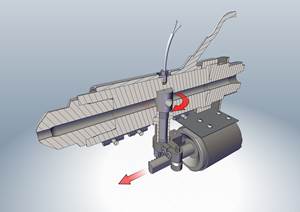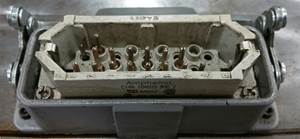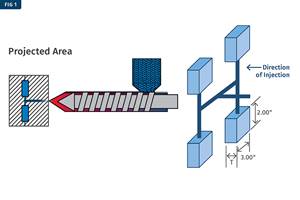Do's and Don'ts for Overmolding Liquid Silicone onto Thermoplastics
Hard/soft overmolding has become a fundamental technique for injection molders in recent years, and a growing number of molders are extending that technology thermoset/thermoplastic combinations.
Hard/soft overmolding has become a fundamental technique for injection molders in recent years, and a growing number of molders are extending that technology thermoset/thermoplastic combinations. In some applications, liquid silicone rubber (LSR) offers advantages over TPEs in its heat resistance, extreme low-temperature flexibility, chemical resistance, and inherent lubricity. While good long-term adhesion can be an issue in overmolding TPEs onto rigid thermoplastic substrates, the challenge is even greater with LSR on thermoplastics.
Preparing the substrate surface with chemical primers or plasma or UV treatment has been one approach to the adhesion challenge. To minimize processing steps, LSR suppliers have come out with newer “primerless” or “self-adhesive” grades that bond well on their own with thermoplastics (see accompanying case history). Even so, there are some rules to observe in order to obtain good results. Here are some key points of advice offered by Eric Bishop, North American marketing manager for Shin-Etsu Silicones of America, Inc. in Akron, Ohio (shinetsusilicones.com). Shin-Etsu supplies Select-Hesive LIMS for primerless adhesion to thermoplastics.
•Keep it clean. “Cleanliness is critical to adhesion, so keep the substrate clean and dry,” says Bishop. That is less of an issue if the substrates are molded in a two-shot mold with the LSR, rather than molded separately and transferred from one machine to another.
•Serve it up hot. “It is vital for substrate parts to be hot,” Bishop states. “The bonding of LSR to the thermoplastic is a chemical reaction. It needs a combination of time, temperature, and pressure. In general, he says, hotter is better. Typical mold temperatures for LSR are 300 to 400 F and the minimum is 250 F. The LSR has to achieve at least that internal temperature to cure adequately. Hotter is also faster—meaning shorter cure cycles.
You also don’t want to overmold LSR onto a cold substrate, which will slow curing, Bishop cautions. In two-shot overmolding that’s not a problem—residual heat in the thermoplastic part will help cure the LSR. But if the substrate is molded separately, it may need preheating in a conveyor oven or with a hot plate.
•Watch out for additives, mold releases. Bishop advises against usin thermoplastic substrates with internal mold releases or “self-lubricating” additives, though they do not always create an adhesion problem. External mold releases are a definite no-no. And avoid any additives containing sulfur or amines, which inhibit cure of LSR. That means amine-based antistats can be a problem.
•Demold gently. Even though LSRs have good “green strength” right out of the mold, when the mold opens, adhesion and curing may not have achieved their final state. So avoid pulling or stretching the LSR during demolding. Bishop notes that a PTFE mold coating can help with release of the LSR.
•Consistency counts. If you follow all the advice above, you should get good results with self-adhesive LSR regardless of whether you use two-shot molding in one machine or separate molding in two machines. But with two machines, it definitely helps to use automated (robotic) transfer from one to the other, Bishop says. That way ensures a consistent substrate temperature for overmolding and also avoids any contamination from a human operator handling parts.
•Mechanical interlock helps. Even with self-bonding LSR, it’s good insurance to incorporate some form of mechanical interlock between the materials into the part design. Allowing LSR to penetrate through-holes onto the back side of the part is a good example. A rough finish on the overmolding interface area can help, but isn’t required with a good self-bonding material.
•Do a preliminary test. To get a good idea of how well your substrate material will bond to a particular LSR grade, it’s a good idea to send a representative part or sample plaque of the substrate material to the LSR supplier for testing.
Related Content
Know Your Options in Injection Machine Nozzles
Improvements in nozzle design in recent years overcome some of the limitations of previous filter, mixing, and shut-off nozzles.
Read MoreA Systematic Approach to Process Development
The path to a no-baby-sitting injection molding process is paved with data and can be found by following certain steps.
Read MoreHot Runners: How to Maintain Heaters, Thermocouples, and Controls
I conclude this three-part examination of real-world problems and solutions involving hot runners by focusing on heaters, thermocouples, and controls. Part 3 of 3.
Read MoreIs There a More Accurate Means to Calculate Tonnage?
Molders have long used the projected area of the parts and runner to guesstimate how much tonnage is required to mold a part without flash, but there’s a more precise methodology.
Read MoreRead Next
People 4.0 – How to Get Buy-In from Your Staff for Industry 4.0 Systems
Implementing a production monitoring system as the foundation of a ‘smart factory’ is about integrating people with new technology as much as it is about integrating machines and computers. Here are tips from a company that has gone through the process.
Read MoreFor PLASTICS' CEO Seaholm, NPE to Shine Light on Sustainability Successes
With advocacy, communication and sustainability as three main pillars, Seaholm leads a trade association to NPE that ‘is more active today than we have ever been.’
Read MoreSee Recyclers Close the Loop on Trade Show Production Scrap at NPE2024
A collaboration between show organizer PLASTICS, recycler CPR and size reduction experts WEIMA and Conair recovered and recycled all production scrap at NPE2024.
Read More












